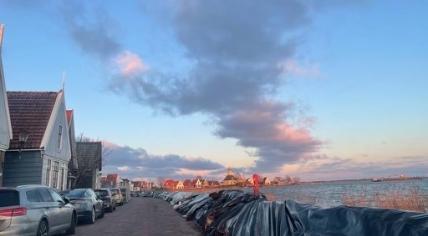
High water levels, flooding issues to persist until winters' end, experts say
High water levels and flooding are currently problems in several parts of the Netherlands, and there is little prospect of improvement, experts say. “We only see the highest groundwater levels at the end of winter: around February or March. We expect that now, too,” Lucas Borst from PWN told NH Nieuws.
The Netherlands has been completely saturated with water due to heavy rainfall since the autumn. The water levels are high in the Markermeer, IJsselmeer, and North Sea - which are all dependent on each other for releasing excess water. The Rhine River passed a high water peak on Sunday for the fourth time since November, and all that water is flowing into the Dutch rivers, including the IJssel River, which flows into the overfull IJsselmeer.
On Sunday, the Rijkswaterstaat opened the discharge sluice in the Oranjesluis complex to drain some water from the Markermeer via the North Sea Canal to the North Sea. “We monitor the water level on the North Sea Canal closely. As long as this level does not become too high, we can use the discharge sluice,” the public works department said. It didn’t say how much relief it hoped this action would bring.
The Noord-Holland towns along the IJsselmeer Coast and the North Sea are all soaking. In Bergen aan Zee, the fire department pumped 1.5 million liters of water from flooded streets into the sea last week. There are also puddles everywhere in the extensive nature reserves around the village. Many dune paths are flooded.
“Pumping out the water in Bergen aan Zee is an emergency measure,” Maarten Kuiper of Aveco de Bondt told the Noord-Holland broadcaster. The agency advises municipalities on groundwater. “Nuisance caused by rain has happened before. But the fact that the groundwater is so high is completely unique. I have never seen it like this before.”
“It rained a lot in the autumn,” Borst said. “Twice more than we are used to. As a result, the water level is now considerably higher.” That is a natural process and very difficult to reverse.
Kuiper also confirmed that the heavy rain is the cause. The rainwater has nowhere to go. “Not to the sea, but also not to the polders around the dunes.” The locks there are already full. “That creates a kind of underground reservoir, with groundwater levels that may rise even further in the coming weeks and months. And if the weather drops, that water will flow, so the villages on the edge of the dunes may also experience problems,” Kuiper said.
Kuiper and Borst both expect this type of problem to occur more often in the future. “For many decades, there has been a little more rain each year,” Borst said. “This causes the groundwater levels to rise; in some places, we have measured a meter increase since 1960.” That trend will continue in the coming decades, he said.
